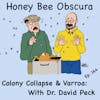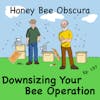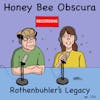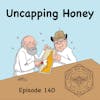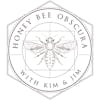Considering the Bee Yard Habitat (138)

Continuing their discussion on the micro and to some extent the macro environment of a beeyard, Kim and Jim take a long hard look at what do bees need to eat, and how much should there be. They look at the weeds in the apiary, areas around the...
 Continuing their discussion on the micro and to some extent the macro environment of a beeyard, Kim and Jim take a long hard look at what do bees need to eat, and how much should there be. They look at the weeds in the apiary, areas around the beeyard, and areas further away that may be a plus because what’s growing out there. They also look at the work beekeepers and other groups are doing to provide additional forage for all pollinators, in an effort to slow the loss of habitat to due development, farms and even climate change.
Continuing their discussion on the micro and to some extent the macro environment of a beeyard, Kim and Jim take a long hard look at what do bees need to eat, and how much should there be. They look at the weeds in the apiary, areas around the beeyard, and areas further away that may be a plus because what’s growing out there. They also look at the work beekeepers and other groups are doing to provide additional forage for all pollinators, in an effort to slow the loss of habitat to due development, farms and even climate change.
It turns out that with careful preselection of a bee yard, and the things a beekeeper can do post selection, life can be made better for both your bees, and you.
Listen in as Jim and Kim bounce these questions around. Is the world is changing, or is it just Kim and Jim trying to make it work the same old way?
- Pollinator Partnership - Bee Friendly Gardening: https://www.pollinator.org/bfg
- Xerces Society Regional Habitat Resource Finder: https://xerces.org/pollinator-resource-center
- Ernst Seed Company: https://www.ernstseed.com/
______________________
Thanks to Betterbee for sponsoring today's episode. Betterbee’s mission is to support every beekeeper with excellent customer  service, continued education and quality equipment. From their colorful and informative catalog to their support of beekeeper educational activities, including this podcast series, Betterbee truly is Beekeepers Serving Beekeepers. See for yourself at www.betterbee.com
service, continued education and quality equipment. From their colorful and informative catalog to their support of beekeeper educational activities, including this podcast series, Betterbee truly is Beekeepers Serving Beekeepers. See for yourself at www.betterbee.com
______________________
Honey Bee Obscura is brought to you by Growing Planet Media, LLC, the home of Beekeeping Today Podcast.
Music: Heart & Soul by Gyom, All We Know by Midway Music, original guitar music by Jeffrey Ott
Copyright © 2023 by Growing Planet Media, LLC

Episode 138 – Considering the Bee Yard Habitat
Kim: Hey, Jim you know, the other day, when we were talking about the things that live in our bee yards besides our bees, of course, and we talked about some of the pests and predators and just the hangers-on, but we didn't talk about plants.
Jim: Kim, I remember it well. It's still on my mind and what an ecosystem is actually in my bee yard besides just bees. I didn't mention anything to do with the plants in my bee yard, surrounding my bee yards, in the community. I mow, cut, trim. I, on occasion Kim, I do put some weed killer out. To mind defense, not much, not nearly as much as I used to. We didn't mention plants and nutrition at all.
[music]
Kim: Hi, I am Kim Flottum.
Jim: I'm Jim Tew.
Kim: Today, we're going to talk a little about, actually we're going to talk a lot about honeybee nutrition and what beekeepers may be able to do to improve honeybee nutrition in their bee yard and around their bee yard.
[music]
Introduction: You are listening to Honey Bee Obscura. Brought to you by Growing Planet Media, the folks behind Beekeeping Today podcast. Each week on Honey Bee Obscura, hosts Kim Flottum and Jim Tew explore the complexities, the beauty, the fun, and the challenges of managing honeybees in today's world. Get ready for an engaging discussion to delight and inform all beekeepers. If you're a long timer or just starting out, sit back and enjoy the next several minutes as Kim and Jim explore all things honeybees.
Jim: Kim, this is a great topic. I hope you know a lot because I could use information. Just like you, I've read one of the major points in the overall situation that we've got in our bee and insect world is nutrition loss. I think, well, I want to do something about that. I want to add viable health and nutrition to my bees and to the beneficial insects in my yard. Problem is, how?
Kim: Good question. There's a lot of roadblocks for most people. Maybe some of them are pretty major. Are you living in the middle of New York City? It's going to be hard to improve that, but it can be done. Are you living on the outskirts of Madison, Wisconsin, or out in the fringe area out there where there's a lot of farmland, some woods, some streams, and lakes? There's that kind of land. There's the desert southwest and there's the humid southeast. Not one answer's going to fill all those, I don't think.
Jim: While you were saying that, I was wondering, okay, so I'm about 60, 50, 60 miles from Cleveland near Akron, Ohio, farmland all around me. I still don't know what to do. I can't go to a soybean farmer, corn producer and say, "Would you plant what, for these bee-beneficial plants?" They've got their own agro-industry going and they're not going to be putting out some crop just for me that affects them. I still don't know what to do even though I'm in an agricultural area.
Kim: That's a problem for lots of beekeepers. There are some things you can do to get around that, kind of. One of the best ones is to roadsides, abandoned lots, railroad track areas, those sorts of things. The power poles that run across the country are all kept pretty mowed and cared for all the time. What you, as a beekeeper, could do is encroach on some of those without wrecking any of them, without destroying any of them and provide some seeds. You go out in the spring, you spread your seeds, it rains, they sprout, they grow. Bees pollinate the flowers, and you got a honey crop. It's not going to be a 40-acre sunflower field, but it's going to be a five-acre mixed bag.
Jim: It sounds to me like just listening to you, that if everybody did a little bit, could I just destroy grammar and say, then we would have a lot of bit of nutrition. It's not like I'm going to go out and plant 200 acres of wildflowers and really benefit my 5 to 10 colonies or whatever. I'm going to plant whatever I can on my acre, and then I'm going to hope and encourage that others do the same thing. Is that where you're going? We all do what we can, but it's probably on an individual basis not going to be enough.
Kim: Well, you might be able to team up with your neighbor or the guy down the road and the two of you work some stretch of land, but you're pretty much right. You're mostly on your own. There is some help out there. There's a bunch of people that got groups going. One of them you get a hold of and you say, "This is where I live. What should I be planting for my bees?" This group's called the pollinator partnership, and they'll send you a planting guide that says this is what bees like and will grow where you live.
Jim: Well, that's a useful reference and I knew that it existed, but I have not studied it closely. What I'm struggling with Kim is this, truthfully, sometimes wildflower plantings can be really pretty and sometimes they can look pretty scruffy. The other thing I don't know what to do with is all the grass and the contaminants that grow in my wildflower planting. I find that I'm drifting away from beekeeping, becoming more of a landscape designer or something. How do I stay beekeeping, worried about swarming, replacing queens at the same time that I'm running all up and down the streets, scattering flower seeds? Can I just admit that it's hard to be helpful, Kim, in this regard?
Kim: It is. Yes. Like I said, there's some groups out there that are trying to make it easier for us. The Xerces Society, we've talked about that before. They have a program called Bee City, and they have a program called Bee Campus, and that's where they've got people at the community level or the university level working to improve nutritional plants for bees. Not just honeybees, but honeybees are going to be right there with them. If you can go to your community and say, here's a possible program, you're going to improve the whole community by planting some of these in the parks and then on the road ditches and things. It's going to help everybody.
Jim: The sad thing is, every time you and I talk, we reminisce. I just can't help Kim because you and I have so many memories and so much past experience. It used to be that way. The roadsides and the ditches and the fence lines used to be that kind of overgrowth and flowering vegetation and there was nothing to be done about it. There were no weed trimmers. There was no Roundup. These plants just ran wild anywhere they wanted. Isn't it interesting that now you're suggesting that we go back to flowering roadsides, and unkept fence roads where we all were 1953 or so. It seems to be the beneficial path. A lot of those weeds and plants were not weeds at all. They were food sources.
Another dirty secret, real quickly, is that you raise all boats, you float all boats when you put these things out. All of a sudden, I've got a really good Japanese beetle crop that's eating everything in sight because I've gotten all this nice floral vegetation. You can't just pick and choose the pollinators and the butterflies that you want to improve. You basically feed everything out there.
Kim: Well, more food to feed, more insects to eat it. You're right, that goes without saying. There are some things you can probably do in choosing the right plants, that planting guide I mentioned. They will let you know that this plant is really susceptible to Japanese beetles and this one is really susceptible to some other pests. You try one, see how it does for a couple of years. It doesn't work. You cut it down. You do another one.
There's another thing going on here that, that I neglected to mention. There's groups like tha,t group in, I think it's Detroit, that the beekeepers in Detroit have formed a coalition and they're working with the city to take over vacant land. The house has been vacated. Nobody wants to buy it. They go in and till it up and plant a honey crop. You get enough of those going. I know there was some of those in New York City too. You get enough of those going and suddenly, you can support a lot of beekeepers and then you've got that problem. That can work too.
Jim: Kim, let's take a break and hear from our sponsor. I want to talk about this some more and get ready for this, I want to ask you what I can do for my bees, that's not required plantings. Can I feed them something? Can I add something to their diet on the hive? Here's our sponsor.
[music]
Betterbee: It's summertime, and the varroa population in your hives is booming. Target varroa now with ApiLife Var to protect your hives from mite-borne diseases down the road. With over 30 years of international use, ApiLife Var is a natural thymol-based treatment with an effectiveness that exceeds 94%. Learn more and get yours from Better Bee Today by visiting betterbee.com/alv.
Jim: Kim, I want you to keep going with this because all through the years, there's been these plots to plant flowers in cities and plant flowers everywhere. It's a good idea that makes really nice pictures and a great article, but it doesn't seem to go much farther than that most of the time. What does it take for that to get a hold? What does it take for these plantings to get a grip and it becomes something that everybody wants to do? Everybody wants a little flower plot somewhere. It just doesn't seem to catch on.
Kim: Well, one of the things that you can work with, some of these groups have worked with, they've worked with farmers who actually are planting some of these as cover crops during the off-season. You've got something there for the end of the summer or the beginning of the spring, and then you've got people who are putting bee crops between rows of corn and what have you.
Corn isn't a good example, but they're filling in the rows in between. If you got a crop out there that isn't going to get sprayed 10 times in the summer, that will work. The same thing with the cover crop. You put the cover crop in, it grows up, it dies, and next year, the farmer comes back and puts soybeans or rice or whatever it is he's growing on there. That's one thing you can do. You can enlist agriculture people.
Jim: What can I do in my backyard? The risk in my front yard that my neighbors can see? What can I do that's not going to be an offense to the neighborhood because the change, the difference in appearance is so shocking? Mowed lawn, mowed lawn, Jim's lawn, what a mess, mowed lawn, mowed lawn. When they ride down the street, I don't want to be the guy who stands out, but I'm always wondering what I can do to just do my little part.
Kim: Here's what I would suggest, and I've seen people do this in the past and I even did it a lot of years ago, is I made a nice flower display in my front yard and the flowers were all bee plants. I got them started if it was necessary in the fall to get them in, get them established, or the next spring to get them established. I followed them for three years, those plants. When did they bloom? When did the bloom start? When did the bloom end? Were there bees on those plants? There were four or five colonies within 20 yards of those plants. There was a population out there.
What I can do is take a look at the plants that can grow where I am. Watch them, measure them, measure all of the beneficial things that they could do, and also, what's going on the whole season? Was last winter too cold and this group of plants died? Was last summer too hot?
I'm not going to improve the amount of forage out there, but I'm going to know a lot more about it. If it's not blooming in my yard, it's probably not blooming out there and then I may have to do what? I may have to feed them.
Jim: That's where I was trying to get to a bit ago. If I just give up on planning and changing values and procedures and ecosystems and I just want to put something on my colony, in the past, I've just put on pollen substitute. I've got it over here in the freezer anyway, you take it out, you throw it out, normally a late winter, early spring food, and then you're done, but what if I put that on right now, late July, early August? Am I helping the nutrient of the colony or am I just wasting my product? I don't know the answer to that.
Kim: I think you're probably feeding small hive beetle mostly.
Jim: Well, I knew that was coming. I know that all through the southeast, if you've got those pollen patties that are not being consumed, that something eats it, and too often, it's small hive beetles.
Kim: You can take that-- I don't want to say artificial diet, but you can take that supplemented diet that you're providing and tomorrow, go out and put pollen traps in every one of your colonies to start collecting pollen and continue it next spring. When you want to put something out there, it's not small hive beetle food. It's regular pollen pellets.
Jim: I'll add that to my list of things that I need to do that I probably won't, but still, we know we brought this up. Kim, I want to go back and tell a short story that has an odd value at this point. The research center I worked at for years planted about an acre of native Ohio wildflowers and they were spectacular. It was right beside essentially a four-lane road, a busy road, and the garden was so attractive that it became a traffic hazard because people were slowing down, in some cases, outright stopping, turning on their flashers to try to get a phone picture of this acre of beautiful flowers in existence.
After about three years, they just let it go because it was causing traffic congestion, traffic hazard, people were coming around, pulling up on the yard, driving on the grass to get that closer, to look at all the butterflies and bee activity. This is the only instance I have of something being too successful. I don't know that they put it anywhere else, but it really served its purpose beautifully just like you and I were talking about, except it did too much.
Kim: You become a public nuisance when you do that. There are people who will not let you do that.
Jim: It was really stunning. Right here in Worcester, there's a homeowner who has a steep bank that runs down to the road sidewalk at the bottom of the bank, and they always plant wildflowers. You know what I've done? I've slowed down, pulled off the edge of the road, got my phone out to try to photograph this whole thing because isn't it sad that it's that unusual that that natural beauty is so unusual that it almost becomes a traffic hazard when you surprise people with it?
Kim: Natural beauty or weedy lawn?
Jim: Weedy lawn. Now you touched a nerve because on the radio here about a week ago, I did that thing where you're coming home and you have to sit in the driveway and finish the story. It was coming out of Mississippi and there were some extension people talking about how to have a pollinator-friendly lawn that was still occasionally mowed. What they were discussing was different varieties of plants that are low growing enough that you can set your mower high and still have a combination of grass and flowers and attract in more of a caring capacity of honeybees and what native bees and other pollinators, or other insects.
The interesting thing that they said on the article was that you need to put a sign out there telling your neighbors exactly what you're doing, that this is a pollinator-friendly lawn, or otherwise, they'll think that your weed control system isn't working. Maybe, just maybe, and this is outside of beekeeping completely, there's other consortiums, other groups that can keep cutting into the concept of a grass lawn, completely pure, not being the total way to go, that there could be alternatives.
Kim: The group that's really, I don't know if they're leading it, but there's a group out there that every year talks about No Mow May, and you let your yard go until the end of May, in which time, the early clovers and whatnot will have bloomed, and then you can mow it because the value of the lawn is gone now that everything's that was going to bloom is bloomed. Your bees have taken advantage of that, but there's another group not far behind them, and they're called No More Mow and they're looking at what your friend with a steep hillside has with, I want this whole yard to be bee plants. I got a homeowner's association that's got a bulldozer ready to change my mind. People are talking.
Jim: People are talking. That's a good way to wind this down. At least people are talking. For the longest time, we just got grass and sprayed everything else, but at least people are talking and these organizations you've listed are good places to go to for advice. I can't say, Kim, that you and I have any definitive answer here. We know that our honey bees and our native bees could really stand a good jolt of nutritional increase but how to go about that, and not offend people who don't have the same values that we do, I guess is the issue.
Kim: I got to run here, I got some bee work I got to get done before the end of the day, but this has been good. I'll remind you on our webpage, we will have the names of these organizations that we've mentioned and some that we haven't, and how to get a hold of them. Click on the link and go take a look at their webpages, the web pages are full of things you can do, how to do things, where to get things, why not to do these sorts of things. There's a lot of information out there. I know a lot of beekeepers knowledge but a lot don't.
Jim: Yes. Well, I enjoyed the conversation. I'll keep scattering flower seed, just hope for the best.
Kim: There you go. Hope for the best. Thanks.
Jim: All right.
Kim: Next time.
Jim: Bye-bye.
[music]
[00:21:03] [END OF AUDIO]
New to Honey Bee Obscura Podcast?
Here are some great episodes to start with. Or, check out episodes by topic.









